An Analysis of Seclusion, Nursing Roles, and Psychotropic Medications
VerifiedAdded on 2022/08/26
|13
|3301
|23
Essay
AI Summary
This essay critically examines the multifaceted aspects of seclusion in mental health, exploring its impact on both consumers and healthcare providers. It delves into the role of a registered nurse within the Safe ward model, emphasizing the importance of safe practices and patient-centered care. The essay further analyzes the impact of psychotropic medications, discussing both the benefits and controversies surrounding their use, and the perspectives of healthcare professionals and patients. It highlights the rising concerns regarding restrictive practices and the movement towards reducing such interventions in psychiatric settings, advocating for improved therapeutic environments and nurse-patient relationships. The paper also touches on the ethical dilemmas of seclusion and the impact of psychotropic drugs in treating mental health disorders. The essay concludes with a comprehensive overview of seclusion practices, medication usage, and the role of nurses in managing mental health patients.
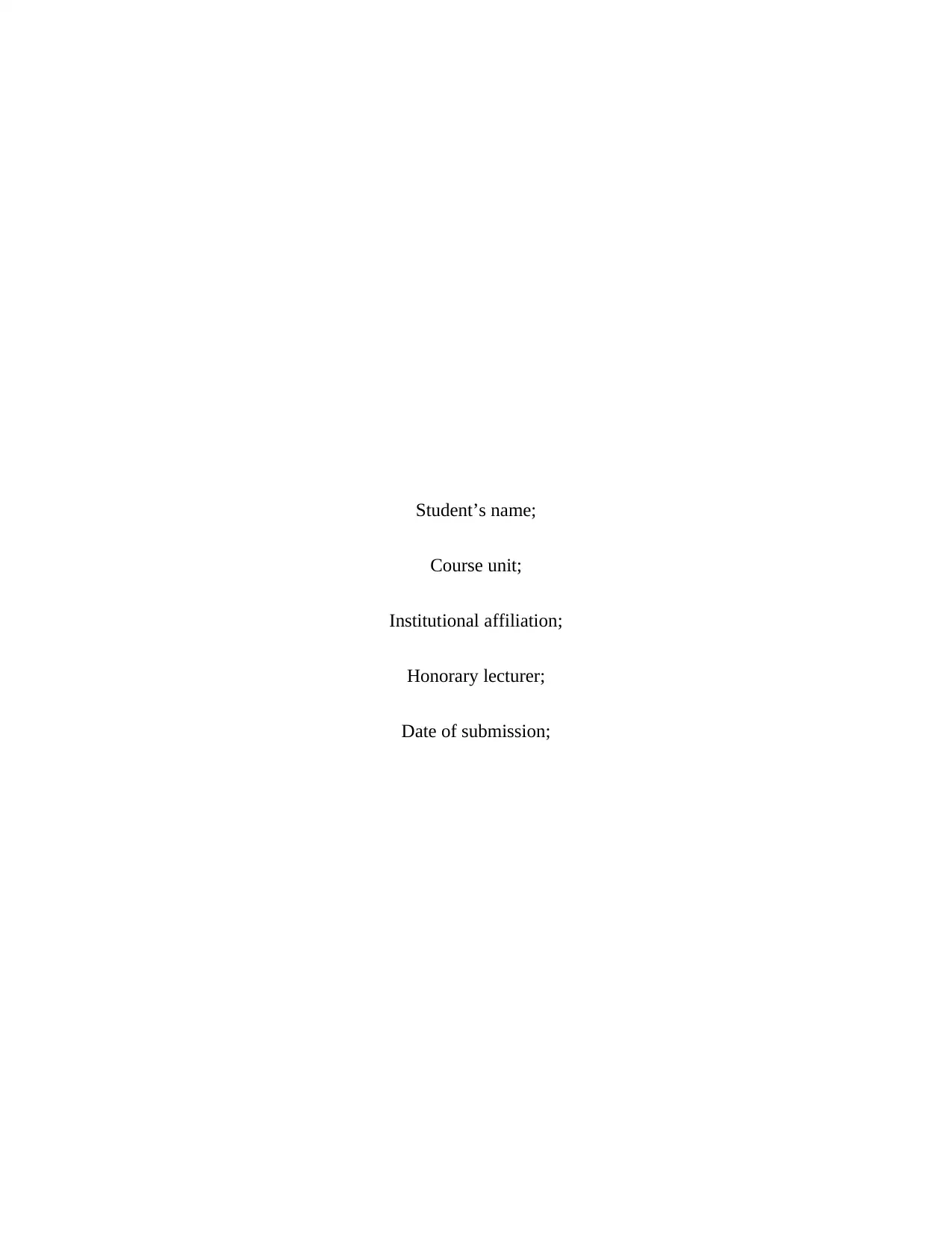
Student’s name;
Course unit;
Institutional affiliation;
Honorary lecturer;
Date of submission;
Course unit;
Institutional affiliation;
Honorary lecturer;
Date of submission;
Paraphrase This Document
Need a fresh take? Get an instant paraphrase of this document with our AI Paraphraser
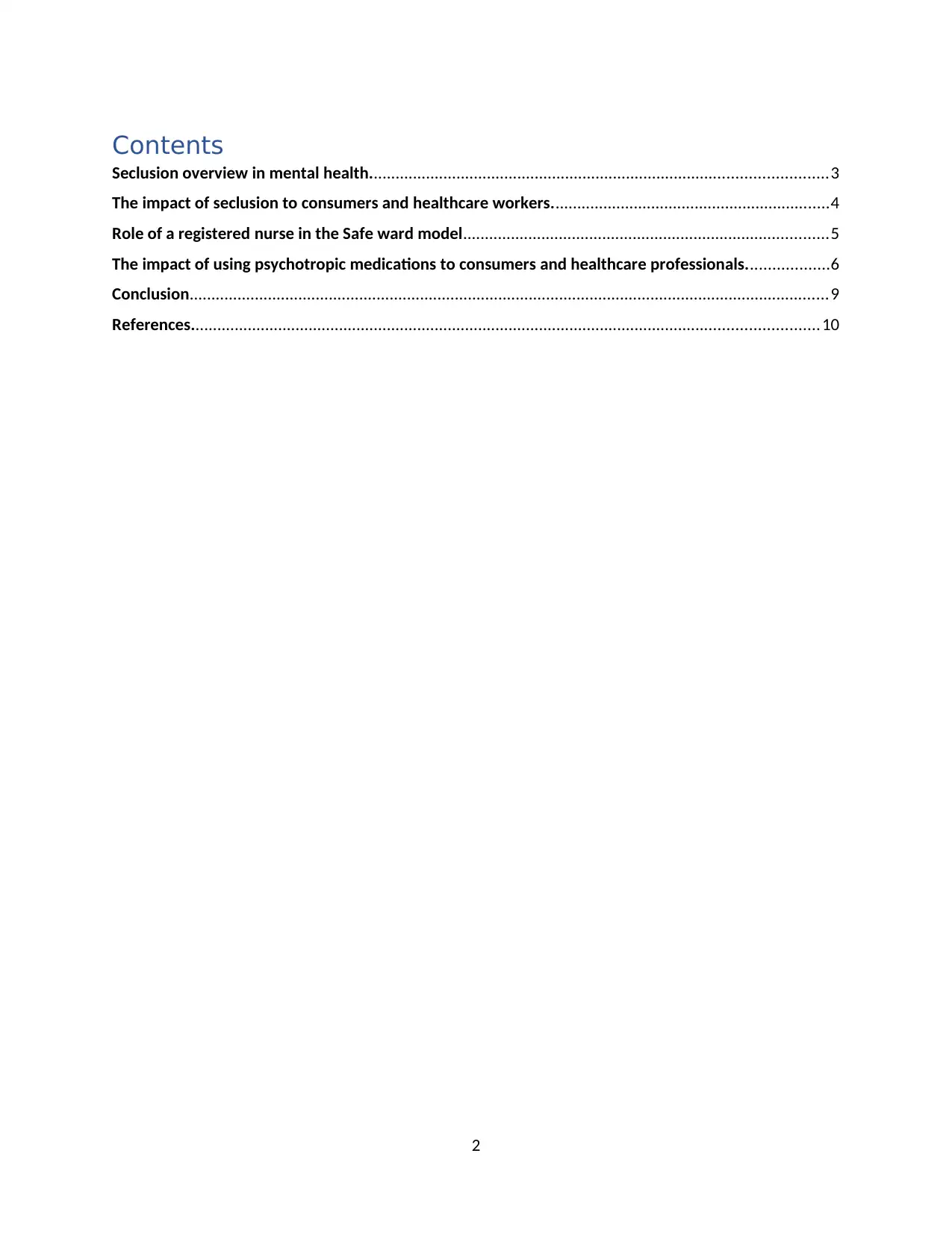
Contents
Seclusion overview in mental health.........................................................................................................3
The impact of seclusion to consumers and healthcare workers................................................................4
Role of a registered nurse in the Safe ward model....................................................................................5
The impact of using psychotropic medications to consumers and healthcare professionals...................6
Conclusion...................................................................................................................................................9
References................................................................................................................................................10
2
Seclusion overview in mental health.........................................................................................................3
The impact of seclusion to consumers and healthcare workers................................................................4
Role of a registered nurse in the Safe ward model....................................................................................5
The impact of using psychotropic medications to consumers and healthcare professionals...................6
Conclusion...................................................................................................................................................9
References................................................................................................................................................10
2
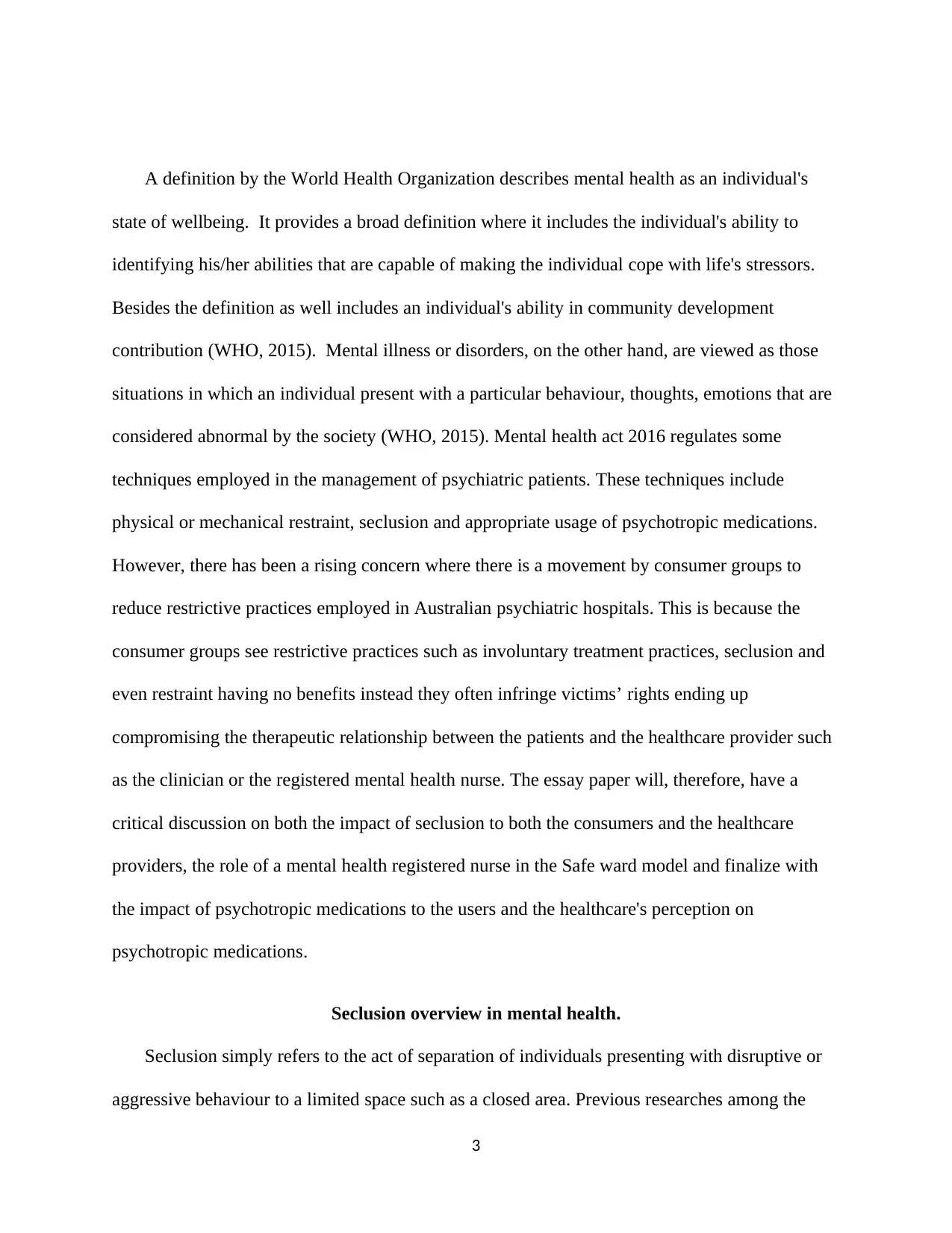
A definition by the World Health Organization describes mental health as an individual's
state of wellbeing. It provides a broad definition where it includes the individual's ability to
identifying his/her abilities that are capable of making the individual cope with life's stressors.
Besides the definition as well includes an individual's ability in community development
contribution (WHO, 2015). Mental illness or disorders, on the other hand, are viewed as those
situations in which an individual present with a particular behaviour, thoughts, emotions that are
considered abnormal by the society (WHO, 2015). Mental health act 2016 regulates some
techniques employed in the management of psychiatric patients. These techniques include
physical or mechanical restraint, seclusion and appropriate usage of psychotropic medications.
However, there has been a rising concern where there is a movement by consumer groups to
reduce restrictive practices employed in Australian psychiatric hospitals. This is because the
consumer groups see restrictive practices such as involuntary treatment practices, seclusion and
even restraint having no benefits instead they often infringe victims’ rights ending up
compromising the therapeutic relationship between the patients and the healthcare provider such
as the clinician or the registered mental health nurse. The essay paper will, therefore, have a
critical discussion on both the impact of seclusion to both the consumers and the healthcare
providers, the role of a mental health registered nurse in the Safe ward model and finalize with
the impact of psychotropic medications to the users and the healthcare's perception on
psychotropic medications.
Seclusion overview in mental health.
Seclusion simply refers to the act of separation of individuals presenting with disruptive or
aggressive behaviour to a limited space such as a closed area. Previous researches among the
3
state of wellbeing. It provides a broad definition where it includes the individual's ability to
identifying his/her abilities that are capable of making the individual cope with life's stressors.
Besides the definition as well includes an individual's ability in community development
contribution (WHO, 2015). Mental illness or disorders, on the other hand, are viewed as those
situations in which an individual present with a particular behaviour, thoughts, emotions that are
considered abnormal by the society (WHO, 2015). Mental health act 2016 regulates some
techniques employed in the management of psychiatric patients. These techniques include
physical or mechanical restraint, seclusion and appropriate usage of psychotropic medications.
However, there has been a rising concern where there is a movement by consumer groups to
reduce restrictive practices employed in Australian psychiatric hospitals. This is because the
consumer groups see restrictive practices such as involuntary treatment practices, seclusion and
even restraint having no benefits instead they often infringe victims’ rights ending up
compromising the therapeutic relationship between the patients and the healthcare provider such
as the clinician or the registered mental health nurse. The essay paper will, therefore, have a
critical discussion on both the impact of seclusion to both the consumers and the healthcare
providers, the role of a mental health registered nurse in the Safe ward model and finalize with
the impact of psychotropic medications to the users and the healthcare's perception on
psychotropic medications.
Seclusion overview in mental health.
Seclusion simply refers to the act of separation of individuals presenting with disruptive or
aggressive behaviour to a limited space such as a closed area. Previous researches among the
3
⊘ This is a preview!⊘
Do you want full access?
Subscribe today to unlock all pages.

Trusted by 1+ million students worldwide
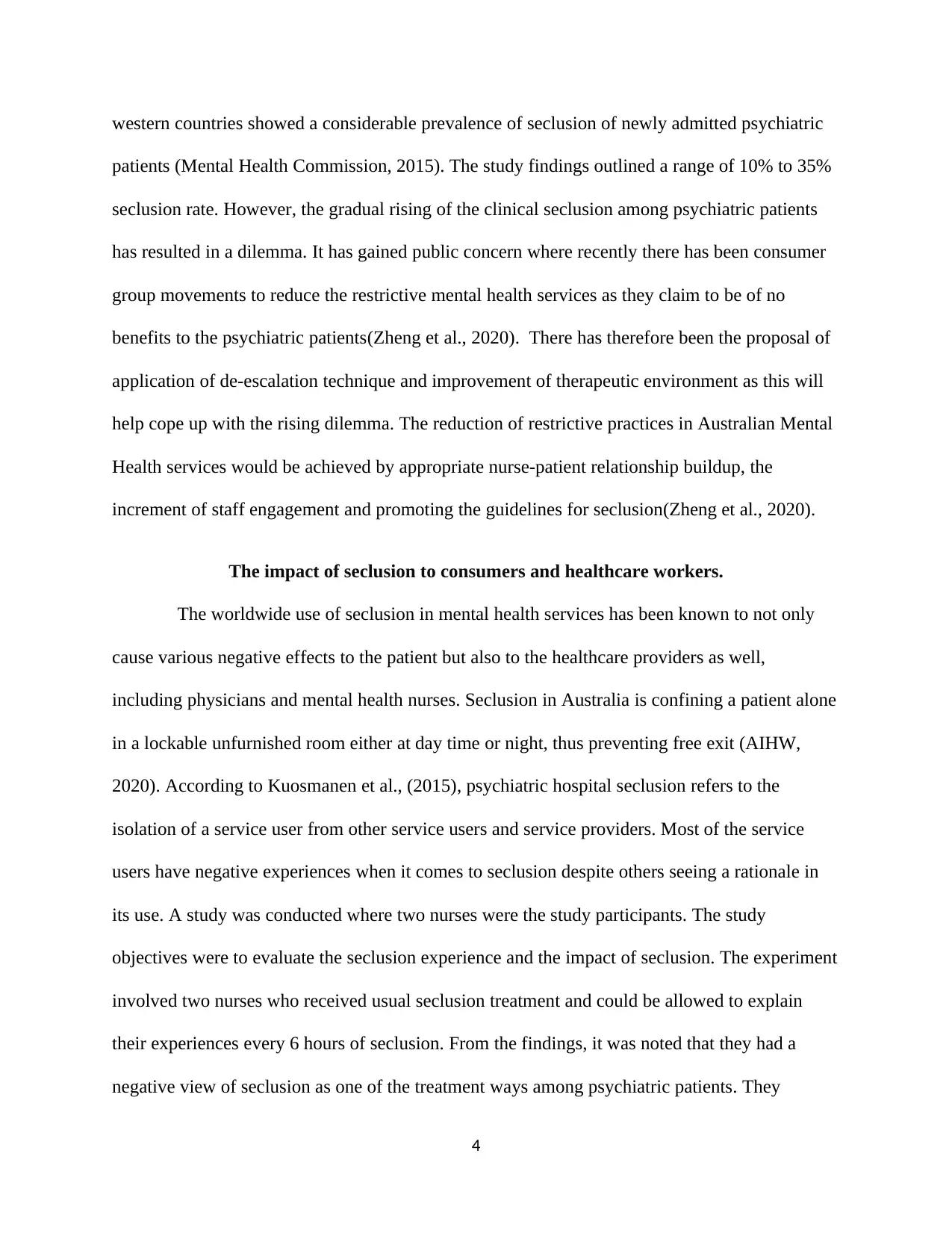
western countries showed a considerable prevalence of seclusion of newly admitted psychiatric
patients (Mental Health Commission, 2015). The study findings outlined a range of 10% to 35%
seclusion rate. However, the gradual rising of the clinical seclusion among psychiatric patients
has resulted in a dilemma. It has gained public concern where recently there has been consumer
group movements to reduce the restrictive mental health services as they claim to be of no
benefits to the psychiatric patients(Zheng et al., 2020). There has therefore been the proposal of
application of de-escalation technique and improvement of therapeutic environment as this will
help cope up with the rising dilemma. The reduction of restrictive practices in Australian Mental
Health services would be achieved by appropriate nurse-patient relationship buildup, the
increment of staff engagement and promoting the guidelines for seclusion(Zheng et al., 2020).
The impact of seclusion to consumers and healthcare workers.
The worldwide use of seclusion in mental health services has been known to not only
cause various negative effects to the patient but also to the healthcare providers as well,
including physicians and mental health nurses. Seclusion in Australia is confining a patient alone
in a lockable unfurnished room either at day time or night, thus preventing free exit (AIHW,
2020). According to Kuosmanen et al., (2015), psychiatric hospital seclusion refers to the
isolation of a service user from other service users and service providers. Most of the service
users have negative experiences when it comes to seclusion despite others seeing a rationale in
its use. A study was conducted where two nurses were the study participants. The study
objectives were to evaluate the seclusion experience and the impact of seclusion. The experiment
involved two nurses who received usual seclusion treatment and could be allowed to explain
their experiences every 6 hours of seclusion. From the findings, it was noted that they had a
negative view of seclusion as one of the treatment ways among psychiatric patients. They
4
patients (Mental Health Commission, 2015). The study findings outlined a range of 10% to 35%
seclusion rate. However, the gradual rising of the clinical seclusion among psychiatric patients
has resulted in a dilemma. It has gained public concern where recently there has been consumer
group movements to reduce the restrictive mental health services as they claim to be of no
benefits to the psychiatric patients(Zheng et al., 2020). There has therefore been the proposal of
application of de-escalation technique and improvement of therapeutic environment as this will
help cope up with the rising dilemma. The reduction of restrictive practices in Australian Mental
Health services would be achieved by appropriate nurse-patient relationship buildup, the
increment of staff engagement and promoting the guidelines for seclusion(Zheng et al., 2020).
The impact of seclusion to consumers and healthcare workers.
The worldwide use of seclusion in mental health services has been known to not only
cause various negative effects to the patient but also to the healthcare providers as well,
including physicians and mental health nurses. Seclusion in Australia is confining a patient alone
in a lockable unfurnished room either at day time or night, thus preventing free exit (AIHW,
2020). According to Kuosmanen et al., (2015), psychiatric hospital seclusion refers to the
isolation of a service user from other service users and service providers. Most of the service
users have negative experiences when it comes to seclusion despite others seeing a rationale in
its use. A study was conducted where two nurses were the study participants. The study
objectives were to evaluate the seclusion experience and the impact of seclusion. The experiment
involved two nurses who received usual seclusion treatment and could be allowed to explain
their experiences every 6 hours of seclusion. From the findings, it was noted that they had a
negative view of seclusion as one of the treatment ways among psychiatric patients. They
4
Paraphrase This Document
Need a fresh take? Get an instant paraphrase of this document with our AI Paraphraser
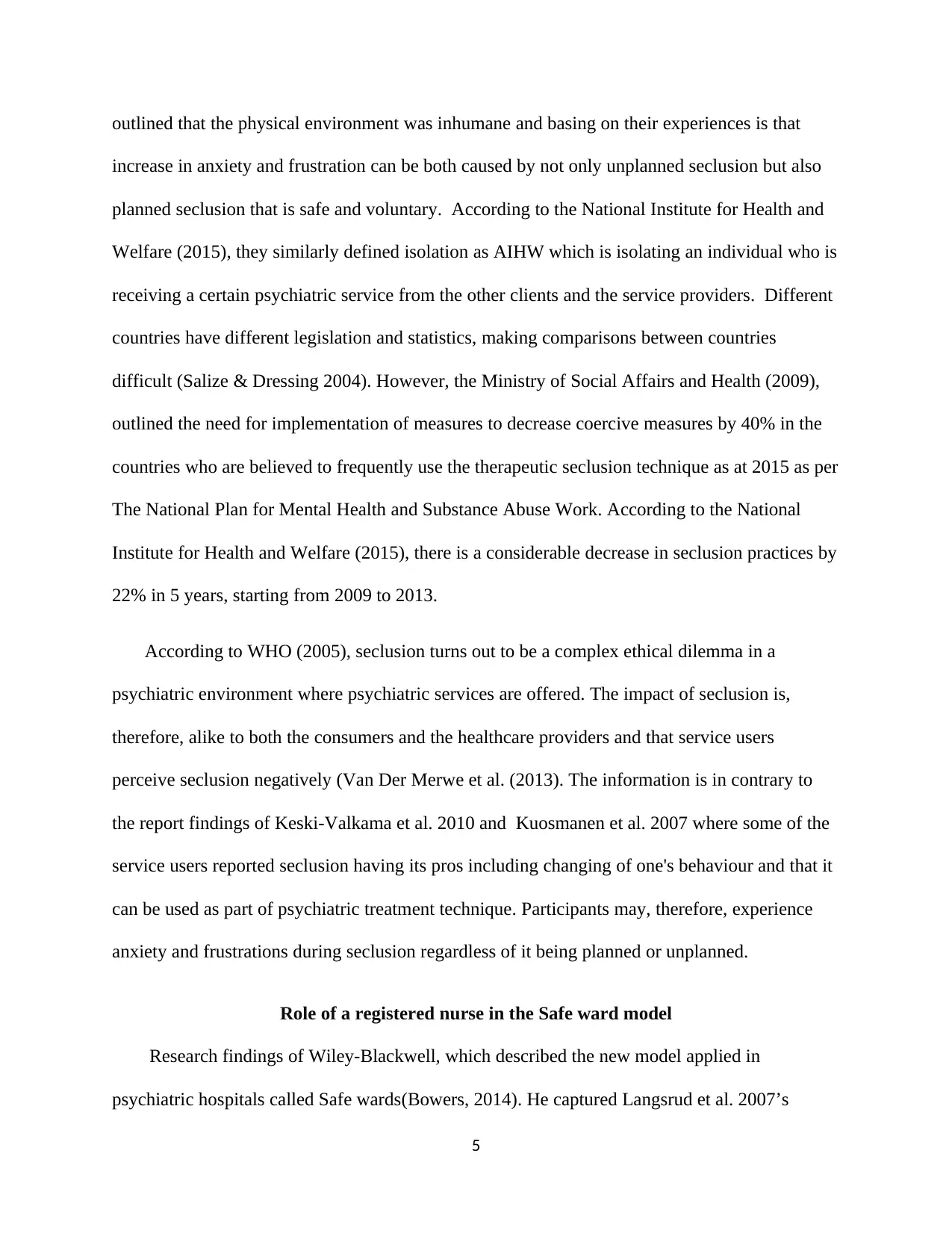
outlined that the physical environment was inhumane and basing on their experiences is that
increase in anxiety and frustration can be both caused by not only unplanned seclusion but also
planned seclusion that is safe and voluntary. According to the National Institute for Health and
Welfare (2015), they similarly defined isolation as AIHW which is isolating an individual who is
receiving a certain psychiatric service from the other clients and the service providers. Different
countries have different legislation and statistics, making comparisons between countries
difficult (Salize & Dressing 2004). However, the Ministry of Social Affairs and Health (2009),
outlined the need for implementation of measures to decrease coercive measures by 40% in the
countries who are believed to frequently use the therapeutic seclusion technique as at 2015 as per
The National Plan for Mental Health and Substance Abuse Work. According to the National
Institute for Health and Welfare (2015), there is a considerable decrease in seclusion practices by
22% in 5 years, starting from 2009 to 2013.
According to WHO (2005), seclusion turns out to be a complex ethical dilemma in a
psychiatric environment where psychiatric services are offered. The impact of seclusion is,
therefore, alike to both the consumers and the healthcare providers and that service users
perceive seclusion negatively (Van Der Merwe et al. (2013). The information is in contrary to
the report findings of Keski-Valkama et al. 2010 and Kuosmanen et al. 2007 where some of the
service users reported seclusion having its pros including changing of one's behaviour and that it
can be used as part of psychiatric treatment technique. Participants may, therefore, experience
anxiety and frustrations during seclusion regardless of it being planned or unplanned.
Role of a registered nurse in the Safe ward model
Research findings of Wiley-Blackwell, which described the new model applied in
psychiatric hospitals called Safe wards(Bowers, 2014). He captured Langsrud et al. 2007’s
5
increase in anxiety and frustration can be both caused by not only unplanned seclusion but also
planned seclusion that is safe and voluntary. According to the National Institute for Health and
Welfare (2015), they similarly defined isolation as AIHW which is isolating an individual who is
receiving a certain psychiatric service from the other clients and the service providers. Different
countries have different legislation and statistics, making comparisons between countries
difficult (Salize & Dressing 2004). However, the Ministry of Social Affairs and Health (2009),
outlined the need for implementation of measures to decrease coercive measures by 40% in the
countries who are believed to frequently use the therapeutic seclusion technique as at 2015 as per
The National Plan for Mental Health and Substance Abuse Work. According to the National
Institute for Health and Welfare (2015), there is a considerable decrease in seclusion practices by
22% in 5 years, starting from 2009 to 2013.
According to WHO (2005), seclusion turns out to be a complex ethical dilemma in a
psychiatric environment where psychiatric services are offered. The impact of seclusion is,
therefore, alike to both the consumers and the healthcare providers and that service users
perceive seclusion negatively (Van Der Merwe et al. (2013). The information is in contrary to
the report findings of Keski-Valkama et al. 2010 and Kuosmanen et al. 2007 where some of the
service users reported seclusion having its pros including changing of one's behaviour and that it
can be used as part of psychiatric treatment technique. Participants may, therefore, experience
anxiety and frustrations during seclusion regardless of it being planned or unplanned.
Role of a registered nurse in the Safe ward model
Research findings of Wiley-Blackwell, which described the new model applied in
psychiatric hospitals called Safe wards(Bowers, 2014). He captured Langsrud et al. 2007’s
5
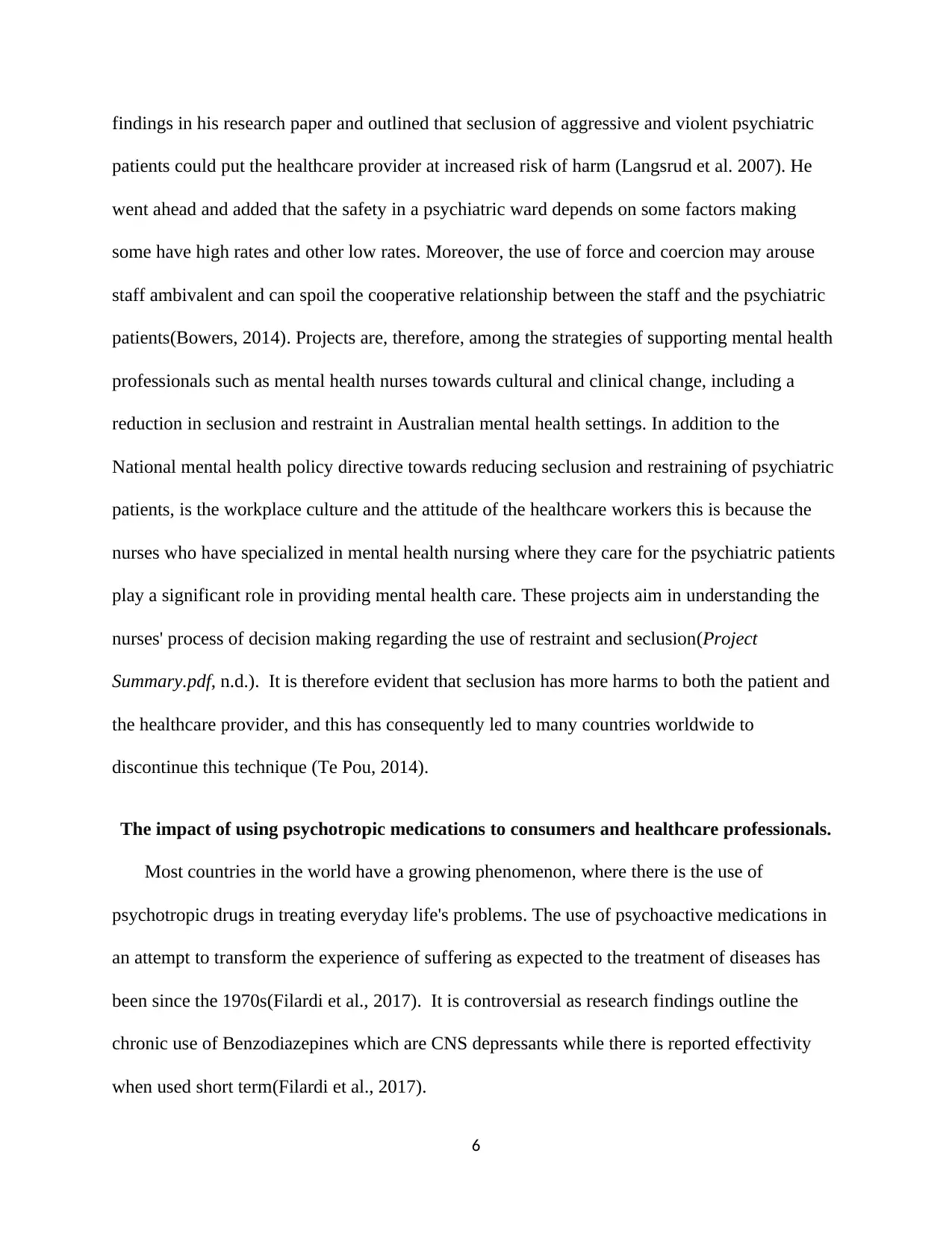
findings in his research paper and outlined that seclusion of aggressive and violent psychiatric
patients could put the healthcare provider at increased risk of harm (Langsrud et al. 2007). He
went ahead and added that the safety in a psychiatric ward depends on some factors making
some have high rates and other low rates. Moreover, the use of force and coercion may arouse
staff ambivalent and can spoil the cooperative relationship between the staff and the psychiatric
patients(Bowers, 2014). Projects are, therefore, among the strategies of supporting mental health
professionals such as mental health nurses towards cultural and clinical change, including a
reduction in seclusion and restraint in Australian mental health settings. In addition to the
National mental health policy directive towards reducing seclusion and restraining of psychiatric
patients, is the workplace culture and the attitude of the healthcare workers this is because the
nurses who have specialized in mental health nursing where they care for the psychiatric patients
play a significant role in providing mental health care. These projects aim in understanding the
nurses' process of decision making regarding the use of restraint and seclusion(Project
Summary.pdf, n.d.). It is therefore evident that seclusion has more harms to both the patient and
the healthcare provider, and this has consequently led to many countries worldwide to
discontinue this technique (Te Pou, 2014).
The impact of using psychotropic medications to consumers and healthcare professionals.
Most countries in the world have a growing phenomenon, where there is the use of
psychotropic drugs in treating everyday life's problems. The use of psychoactive medications in
an attempt to transform the experience of suffering as expected to the treatment of diseases has
been since the 1970s(Filardi et al., 2017). It is controversial as research findings outline the
chronic use of Benzodiazepines which are CNS depressants while there is reported effectivity
when used short term(Filardi et al., 2017).
6
patients could put the healthcare provider at increased risk of harm (Langsrud et al. 2007). He
went ahead and added that the safety in a psychiatric ward depends on some factors making
some have high rates and other low rates. Moreover, the use of force and coercion may arouse
staff ambivalent and can spoil the cooperative relationship between the staff and the psychiatric
patients(Bowers, 2014). Projects are, therefore, among the strategies of supporting mental health
professionals such as mental health nurses towards cultural and clinical change, including a
reduction in seclusion and restraint in Australian mental health settings. In addition to the
National mental health policy directive towards reducing seclusion and restraining of psychiatric
patients, is the workplace culture and the attitude of the healthcare workers this is because the
nurses who have specialized in mental health nursing where they care for the psychiatric patients
play a significant role in providing mental health care. These projects aim in understanding the
nurses' process of decision making regarding the use of restraint and seclusion(Project
Summary.pdf, n.d.). It is therefore evident that seclusion has more harms to both the patient and
the healthcare provider, and this has consequently led to many countries worldwide to
discontinue this technique (Te Pou, 2014).
The impact of using psychotropic medications to consumers and healthcare professionals.
Most countries in the world have a growing phenomenon, where there is the use of
psychotropic drugs in treating everyday life's problems. The use of psychoactive medications in
an attempt to transform the experience of suffering as expected to the treatment of diseases has
been since the 1970s(Filardi et al., 2017). It is controversial as research findings outline the
chronic use of Benzodiazepines which are CNS depressants while there is reported effectivity
when used short term(Filardi et al., 2017).
6
⊘ This is a preview!⊘
Do you want full access?
Subscribe today to unlock all pages.

Trusted by 1+ million students worldwide
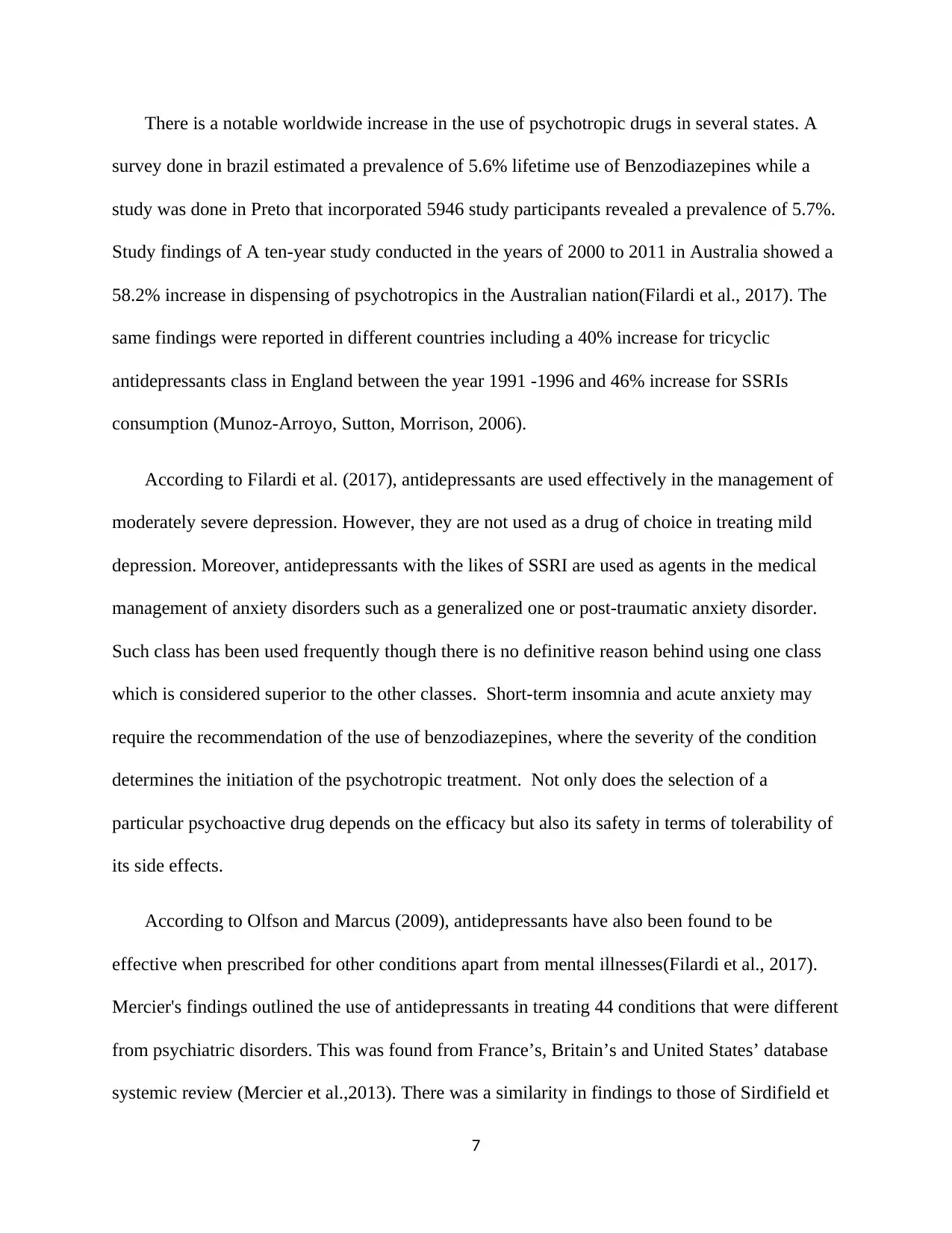
There is a notable worldwide increase in the use of psychotropic drugs in several states. A
survey done in brazil estimated a prevalence of 5.6% lifetime use of Benzodiazepines while a
study was done in Preto that incorporated 5946 study participants revealed a prevalence of 5.7%.
Study findings of A ten-year study conducted in the years of 2000 to 2011 in Australia showed a
58.2% increase in dispensing of psychotropics in the Australian nation(Filardi et al., 2017). The
same findings were reported in different countries including a 40% increase for tricyclic
antidepressants class in England between the year 1991 -1996 and 46% increase for SSRIs
consumption (Munoz-Arroyo, Sutton, Morrison, 2006).
According to Filardi et al. (2017), antidepressants are used effectively in the management of
moderately severe depression. However, they are not used as a drug of choice in treating mild
depression. Moreover, antidepressants with the likes of SSRI are used as agents in the medical
management of anxiety disorders such as a generalized one or post-traumatic anxiety disorder.
Such class has been used frequently though there is no definitive reason behind using one class
which is considered superior to the other classes. Short-term insomnia and acute anxiety may
require the recommendation of the use of benzodiazepines, where the severity of the condition
determines the initiation of the psychotropic treatment. Not only does the selection of a
particular psychoactive drug depends on the efficacy but also its safety in terms of tolerability of
its side effects.
According to Olfson and Marcus (2009), antidepressants have also been found to be
effective when prescribed for other conditions apart from mental illnesses(Filardi et al., 2017).
Mercier's findings outlined the use of antidepressants in treating 44 conditions that were different
from psychiatric disorders. This was found from France’s, Britain’s and United States’ database
systemic review (Mercier et al.,2013). There was a similarity in findings to those of Sirdifield et
7
survey done in brazil estimated a prevalence of 5.6% lifetime use of Benzodiazepines while a
study was done in Preto that incorporated 5946 study participants revealed a prevalence of 5.7%.
Study findings of A ten-year study conducted in the years of 2000 to 2011 in Australia showed a
58.2% increase in dispensing of psychotropics in the Australian nation(Filardi et al., 2017). The
same findings were reported in different countries including a 40% increase for tricyclic
antidepressants class in England between the year 1991 -1996 and 46% increase for SSRIs
consumption (Munoz-Arroyo, Sutton, Morrison, 2006).
According to Filardi et al. (2017), antidepressants are used effectively in the management of
moderately severe depression. However, they are not used as a drug of choice in treating mild
depression. Moreover, antidepressants with the likes of SSRI are used as agents in the medical
management of anxiety disorders such as a generalized one or post-traumatic anxiety disorder.
Such class has been used frequently though there is no definitive reason behind using one class
which is considered superior to the other classes. Short-term insomnia and acute anxiety may
require the recommendation of the use of benzodiazepines, where the severity of the condition
determines the initiation of the psychotropic treatment. Not only does the selection of a
particular psychoactive drug depends on the efficacy but also its safety in terms of tolerability of
its side effects.
According to Olfson and Marcus (2009), antidepressants have also been found to be
effective when prescribed for other conditions apart from mental illnesses(Filardi et al., 2017).
Mercier's findings outlined the use of antidepressants in treating 44 conditions that were different
from psychiatric disorders. This was found from France’s, Britain’s and United States’ database
systemic review (Mercier et al.,2013). There was a similarity in findings to those of Sirdifield et
7
Paraphrase This Document
Need a fresh take? Get an instant paraphrase of this document with our AI Paraphraser
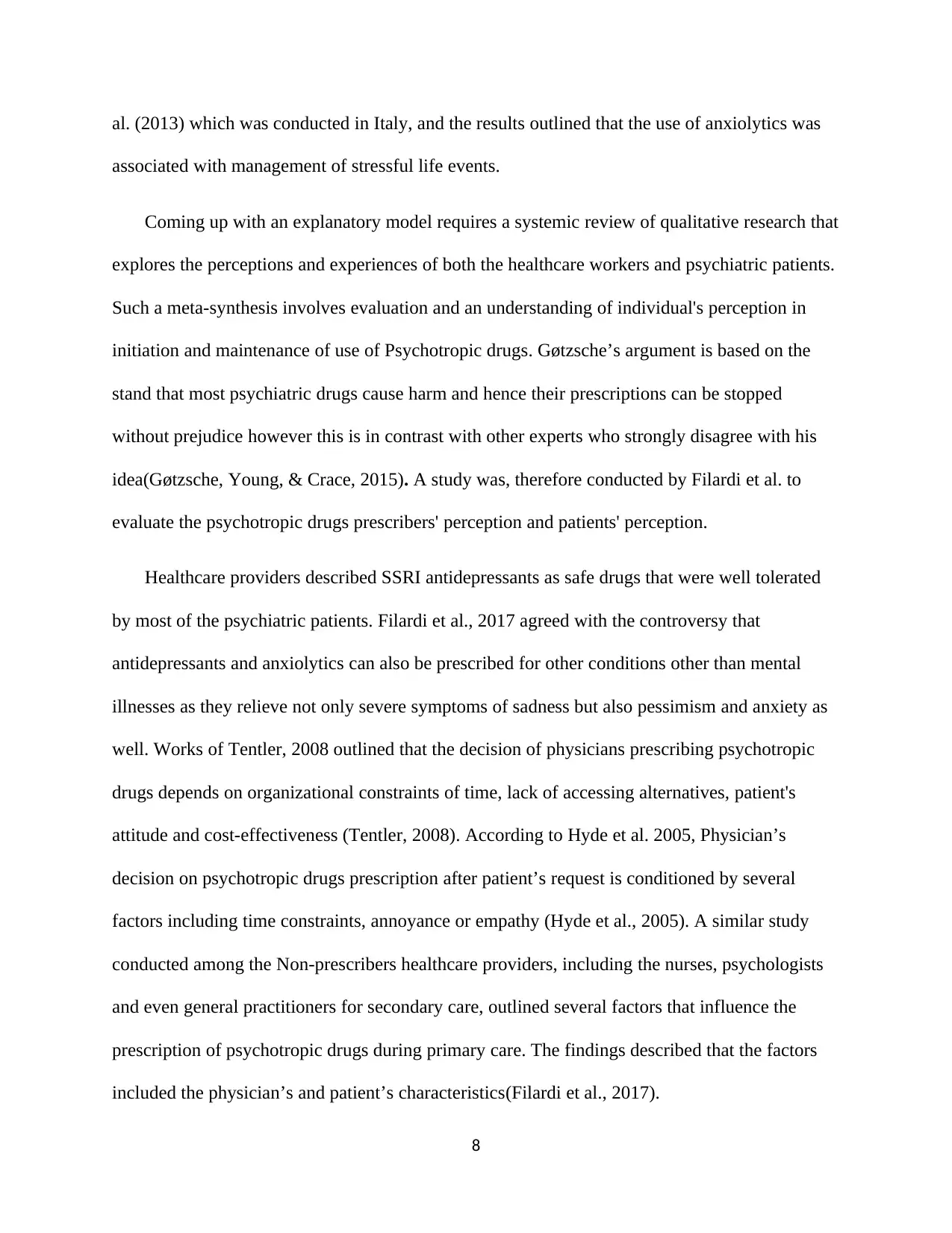
al. (2013) which was conducted in Italy, and the results outlined that the use of anxiolytics was
associated with management of stressful life events.
Coming up with an explanatory model requires a systemic review of qualitative research that
explores the perceptions and experiences of both the healthcare workers and psychiatric patients.
Such a meta-synthesis involves evaluation and an understanding of individual's perception in
initiation and maintenance of use of Psychotropic drugs. Gøtzsche’s argument is based on the
stand that most psychiatric drugs cause harm and hence their prescriptions can be stopped
without prejudice however this is in contrast with other experts who strongly disagree with his
idea(Gøtzsche, Young, & Crace, 2015). A study was, therefore conducted by Filardi et al. to
evaluate the psychotropic drugs prescribers' perception and patients' perception.
Healthcare providers described SSRI antidepressants as safe drugs that were well tolerated
by most of the psychiatric patients. Filardi et al., 2017 agreed with the controversy that
antidepressants and anxiolytics can also be prescribed for other conditions other than mental
illnesses as they relieve not only severe symptoms of sadness but also pessimism and anxiety as
well. Works of Tentler, 2008 outlined that the decision of physicians prescribing psychotropic
drugs depends on organizational constraints of time, lack of accessing alternatives, patient's
attitude and cost-effectiveness (Tentler, 2008). According to Hyde et al. 2005, Physician’s
decision on psychotropic drugs prescription after patient’s request is conditioned by several
factors including time constraints, annoyance or empathy (Hyde et al., 2005). A similar study
conducted among the Non-prescribers healthcare providers, including the nurses, psychologists
and even general practitioners for secondary care, outlined several factors that influence the
prescription of psychotropic drugs during primary care. The findings described that the factors
included the physician’s and patient’s characteristics(Filardi et al., 2017).
8
associated with management of stressful life events.
Coming up with an explanatory model requires a systemic review of qualitative research that
explores the perceptions and experiences of both the healthcare workers and psychiatric patients.
Such a meta-synthesis involves evaluation and an understanding of individual's perception in
initiation and maintenance of use of Psychotropic drugs. Gøtzsche’s argument is based on the
stand that most psychiatric drugs cause harm and hence their prescriptions can be stopped
without prejudice however this is in contrast with other experts who strongly disagree with his
idea(Gøtzsche, Young, & Crace, 2015). A study was, therefore conducted by Filardi et al. to
evaluate the psychotropic drugs prescribers' perception and patients' perception.
Healthcare providers described SSRI antidepressants as safe drugs that were well tolerated
by most of the psychiatric patients. Filardi et al., 2017 agreed with the controversy that
antidepressants and anxiolytics can also be prescribed for other conditions other than mental
illnesses as they relieve not only severe symptoms of sadness but also pessimism and anxiety as
well. Works of Tentler, 2008 outlined that the decision of physicians prescribing psychotropic
drugs depends on organizational constraints of time, lack of accessing alternatives, patient's
attitude and cost-effectiveness (Tentler, 2008). According to Hyde et al. 2005, Physician’s
decision on psychotropic drugs prescription after patient’s request is conditioned by several
factors including time constraints, annoyance or empathy (Hyde et al., 2005). A similar study
conducted among the Non-prescribers healthcare providers, including the nurses, psychologists
and even general practitioners for secondary care, outlined several factors that influence the
prescription of psychotropic drugs during primary care. The findings described that the factors
included the physician’s and patient’s characteristics(Filardi et al., 2017).
8
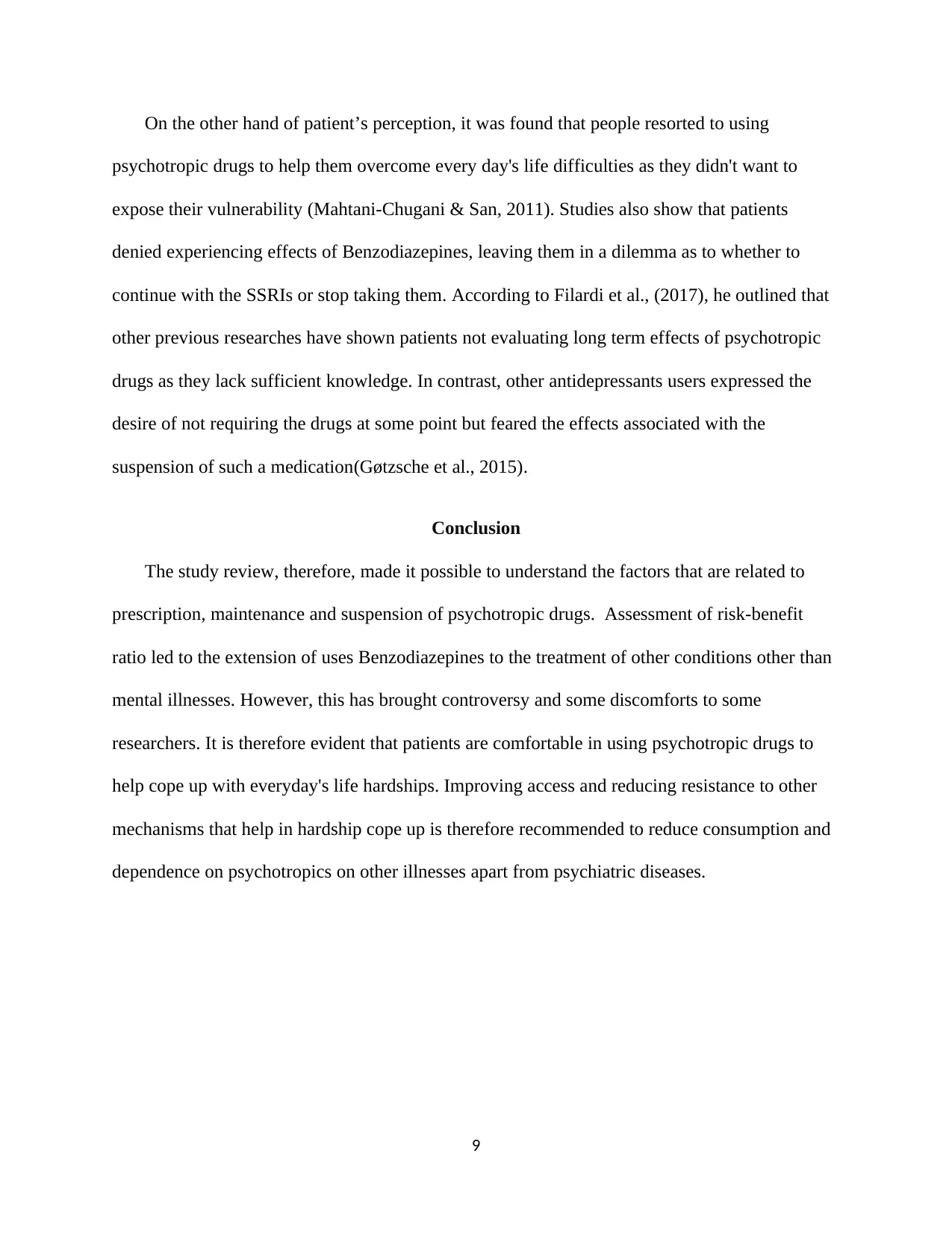
On the other hand of patient’s perception, it was found that people resorted to using
psychotropic drugs to help them overcome every day's life difficulties as they didn't want to
expose their vulnerability (Mahtani-Chugani & San, 2011). Studies also show that patients
denied experiencing effects of Benzodiazepines, leaving them in a dilemma as to whether to
continue with the SSRIs or stop taking them. According to Filardi et al., (2017), he outlined that
other previous researches have shown patients not evaluating long term effects of psychotropic
drugs as they lack sufficient knowledge. In contrast, other antidepressants users expressed the
desire of not requiring the drugs at some point but feared the effects associated with the
suspension of such a medication(Gøtzsche et al., 2015).
Conclusion
The study review, therefore, made it possible to understand the factors that are related to
prescription, maintenance and suspension of psychotropic drugs. Assessment of risk-benefit
ratio led to the extension of uses Benzodiazepines to the treatment of other conditions other than
mental illnesses. However, this has brought controversy and some discomforts to some
researchers. It is therefore evident that patients are comfortable in using psychotropic drugs to
help cope up with everyday's life hardships. Improving access and reducing resistance to other
mechanisms that help in hardship cope up is therefore recommended to reduce consumption and
dependence on psychotropics on other illnesses apart from psychiatric diseases.
9
psychotropic drugs to help them overcome every day's life difficulties as they didn't want to
expose their vulnerability (Mahtani-Chugani & San, 2011). Studies also show that patients
denied experiencing effects of Benzodiazepines, leaving them in a dilemma as to whether to
continue with the SSRIs or stop taking them. According to Filardi et al., (2017), he outlined that
other previous researches have shown patients not evaluating long term effects of psychotropic
drugs as they lack sufficient knowledge. In contrast, other antidepressants users expressed the
desire of not requiring the drugs at some point but feared the effects associated with the
suspension of such a medication(Gøtzsche et al., 2015).
Conclusion
The study review, therefore, made it possible to understand the factors that are related to
prescription, maintenance and suspension of psychotropic drugs. Assessment of risk-benefit
ratio led to the extension of uses Benzodiazepines to the treatment of other conditions other than
mental illnesses. However, this has brought controversy and some discomforts to some
researchers. It is therefore evident that patients are comfortable in using psychotropic drugs to
help cope up with everyday's life hardships. Improving access and reducing resistance to other
mechanisms that help in hardship cope up is therefore recommended to reduce consumption and
dependence on psychotropics on other illnesses apart from psychiatric diseases.
9
⊘ This is a preview!⊘
Do you want full access?
Subscribe today to unlock all pages.

Trusted by 1+ million students worldwide
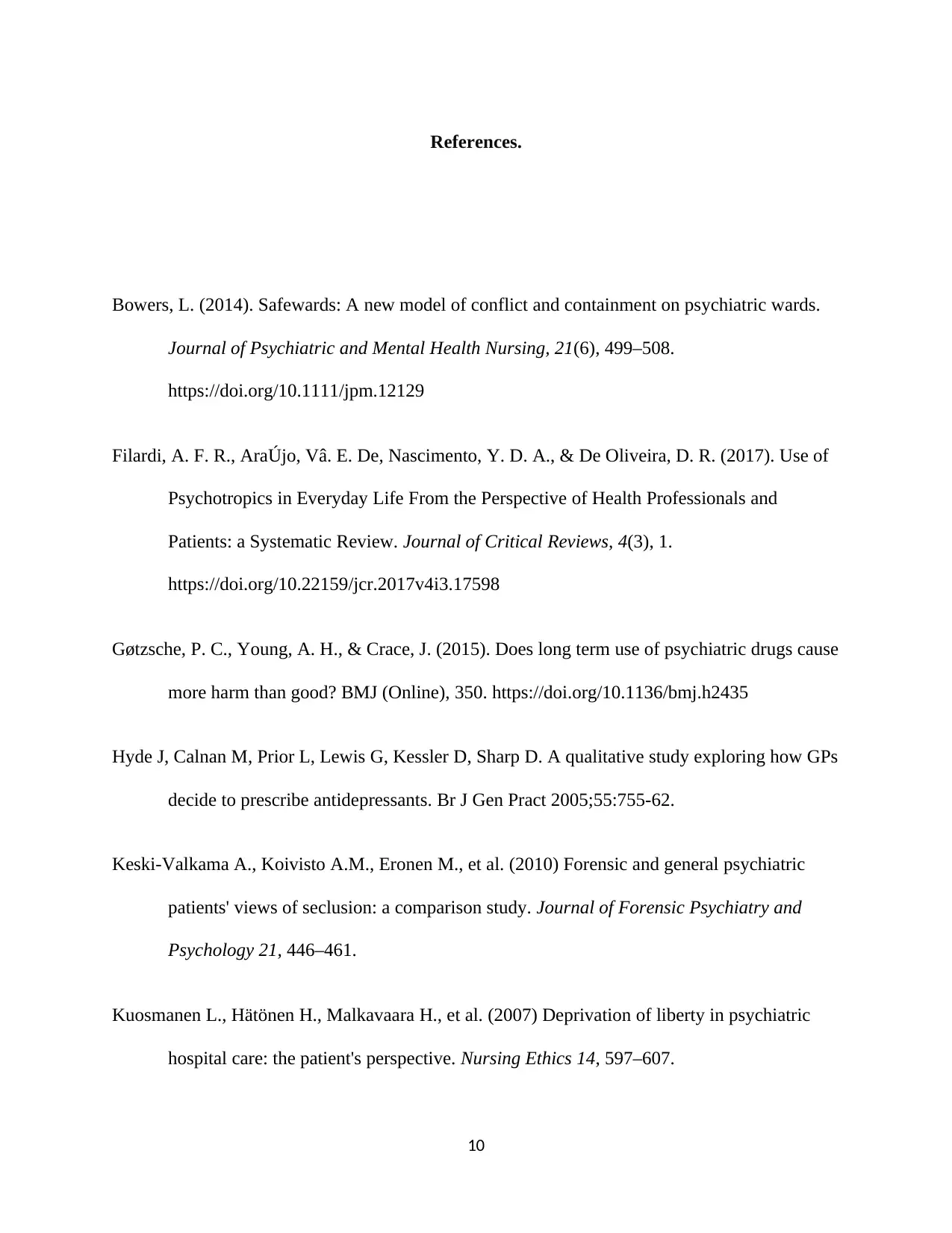
References.
Bowers, L. (2014). Safewards: A new model of conflict and containment on psychiatric wards.
Journal of Psychiatric and Mental Health Nursing, 21(6), 499–508.
https://doi.org/10.1111/jpm.12129
Filardi, A. F. R., AraÚjo, Vâ. E. De, Nascimento, Y. D. A., & De Oliveira, D. R. (2017). Use of
Psychotropics in Everyday Life From the Perspective of Health Professionals and
Patients: a Systematic Review. Journal of Critical Reviews, 4(3), 1.
https://doi.org/10.22159/jcr.2017v4i3.17598
Gøtzsche, P. C., Young, A. H., & Crace, J. (2015). Does long term use of psychiatric drugs cause
more harm than good? BMJ (Online), 350. https://doi.org/10.1136/bmj.h2435
Hyde J, Calnan M, Prior L, Lewis G, Kessler D, Sharp D. A qualitative study exploring how GPs
decide to prescribe antidepressants. Br J Gen Pract 2005;55:755-62.
Keski-Valkama A., Koivisto A.M., Eronen M., et al. (2010) Forensic and general psychiatric
patients' views of seclusion: a comparison study. Journal of Forensic Psychiatry and
Psychology 21, 446–461.
Kuosmanen L., Hätönen H., Malkavaara H., et al. (2007) Deprivation of liberty in psychiatric
hospital care: the patient's perspective. Nursing Ethics 14, 597–607.
10
Bowers, L. (2014). Safewards: A new model of conflict and containment on psychiatric wards.
Journal of Psychiatric and Mental Health Nursing, 21(6), 499–508.
https://doi.org/10.1111/jpm.12129
Filardi, A. F. R., AraÚjo, Vâ. E. De, Nascimento, Y. D. A., & De Oliveira, D. R. (2017). Use of
Psychotropics in Everyday Life From the Perspective of Health Professionals and
Patients: a Systematic Review. Journal of Critical Reviews, 4(3), 1.
https://doi.org/10.22159/jcr.2017v4i3.17598
Gøtzsche, P. C., Young, A. H., & Crace, J. (2015). Does long term use of psychiatric drugs cause
more harm than good? BMJ (Online), 350. https://doi.org/10.1136/bmj.h2435
Hyde J, Calnan M, Prior L, Lewis G, Kessler D, Sharp D. A qualitative study exploring how GPs
decide to prescribe antidepressants. Br J Gen Pract 2005;55:755-62.
Keski-Valkama A., Koivisto A.M., Eronen M., et al. (2010) Forensic and general psychiatric
patients' views of seclusion: a comparison study. Journal of Forensic Psychiatry and
Psychology 21, 446–461.
Kuosmanen L., Hätönen H., Malkavaara H., et al. (2007) Deprivation of liberty in psychiatric
hospital care: the patient's perspective. Nursing Ethics 14, 597–607.
10
Paraphrase This Document
Need a fresh take? Get an instant paraphrase of this document with our AI Paraphraser
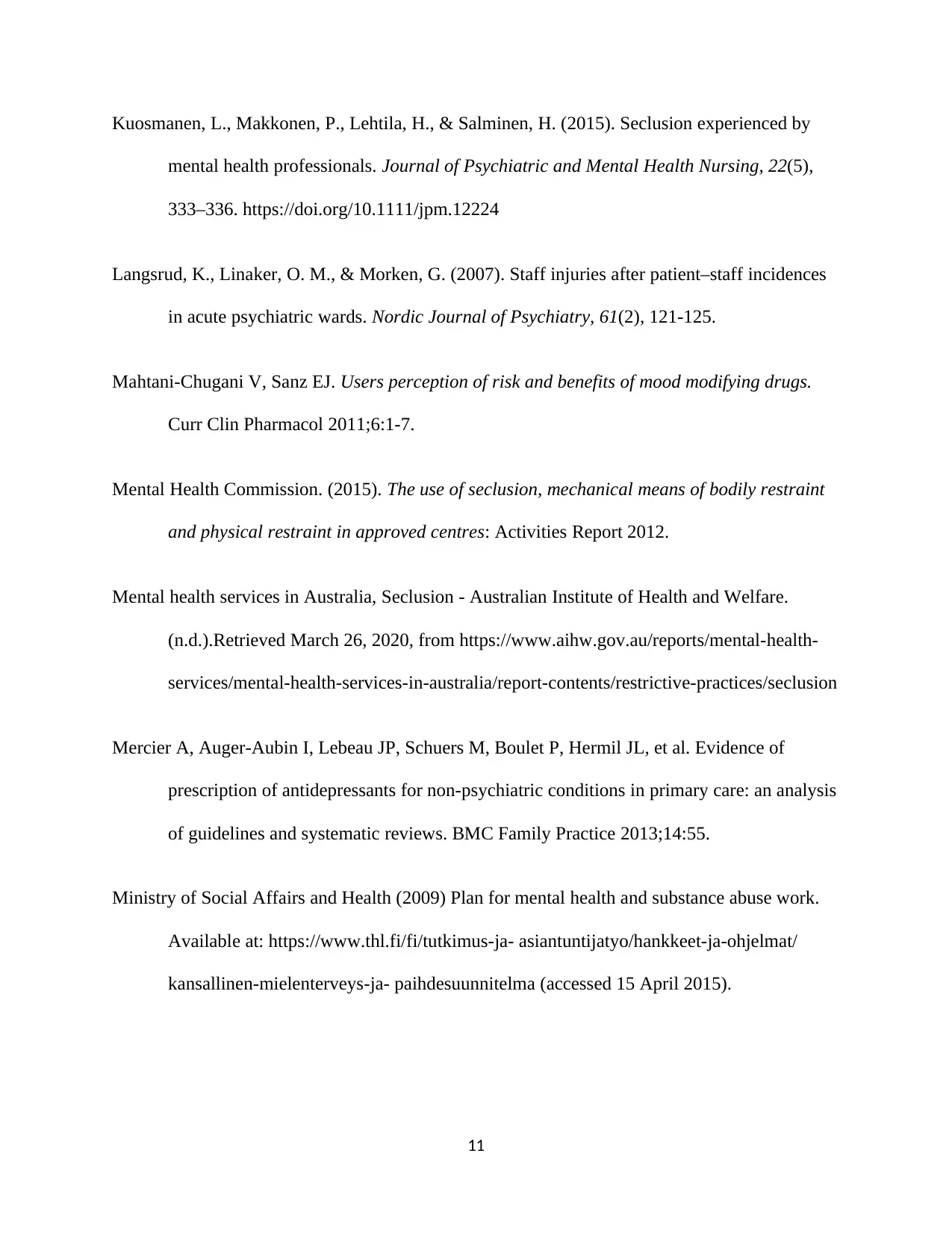
Kuosmanen, L., Makkonen, P., Lehtila, H., & Salminen, H. (2015). Seclusion experienced by
mental health professionals. Journal of Psychiatric and Mental Health Nursing, 22(5),
333–336. https://doi.org/10.1111/jpm.12224
Langsrud, K., Linaker, O. M., & Morken, G. (2007). Staff injuries after patient–staff incidences
in acute psychiatric wards. Nordic Journal of Psychiatry, 61(2), 121-125.
Mahtani-Chugani V, Sanz EJ. Users perception of risk and benefits of mood modifying drugs.
Curr Clin Pharmacol 2011;6:1-7.
Mental Health Commission. (2015). The use of seclusion, mechanical means of bodily restraint
and physical restraint in approved centres: Activities Report 2012.
Mental health services in Australia, Seclusion - Australian Institute of Health and Welfare.
(n.d.).Retrieved March 26, 2020, from https://www.aihw.gov.au/reports/mental-health-
services/mental-health-services-in-australia/report-contents/restrictive-practices/seclusion
Mercier A, Auger-Aubin I, Lebeau JP, Schuers M, Boulet P, Hermil JL, et al. Evidence of
prescription of antidepressants for non-psychiatric conditions in primary care: an analysis
of guidelines and systematic reviews. BMC Family Practice 2013;14:55.
Ministry of Social Affairs and Health (2009) Plan for mental health and substance abuse work.
Available at: https://www.thl.fi/fi/tutkimus-ja- asiantuntijatyo/hankkeet-ja-ohjelmat/
kansallinen-mielenterveys-ja- paihdesuunnitelma (accessed 15 April 2015).
11
mental health professionals. Journal of Psychiatric and Mental Health Nursing, 22(5),
333–336. https://doi.org/10.1111/jpm.12224
Langsrud, K., Linaker, O. M., & Morken, G. (2007). Staff injuries after patient–staff incidences
in acute psychiatric wards. Nordic Journal of Psychiatry, 61(2), 121-125.
Mahtani-Chugani V, Sanz EJ. Users perception of risk and benefits of mood modifying drugs.
Curr Clin Pharmacol 2011;6:1-7.
Mental Health Commission. (2015). The use of seclusion, mechanical means of bodily restraint
and physical restraint in approved centres: Activities Report 2012.
Mental health services in Australia, Seclusion - Australian Institute of Health and Welfare.
(n.d.).Retrieved March 26, 2020, from https://www.aihw.gov.au/reports/mental-health-
services/mental-health-services-in-australia/report-contents/restrictive-practices/seclusion
Mercier A, Auger-Aubin I, Lebeau JP, Schuers M, Boulet P, Hermil JL, et al. Evidence of
prescription of antidepressants for non-psychiatric conditions in primary care: an analysis
of guidelines and systematic reviews. BMC Family Practice 2013;14:55.
Ministry of Social Affairs and Health (2009) Plan for mental health and substance abuse work.
Available at: https://www.thl.fi/fi/tutkimus-ja- asiantuntijatyo/hankkeet-ja-ohjelmat/
kansallinen-mielenterveys-ja- paihdesuunnitelma (accessed 15 April 2015).
11
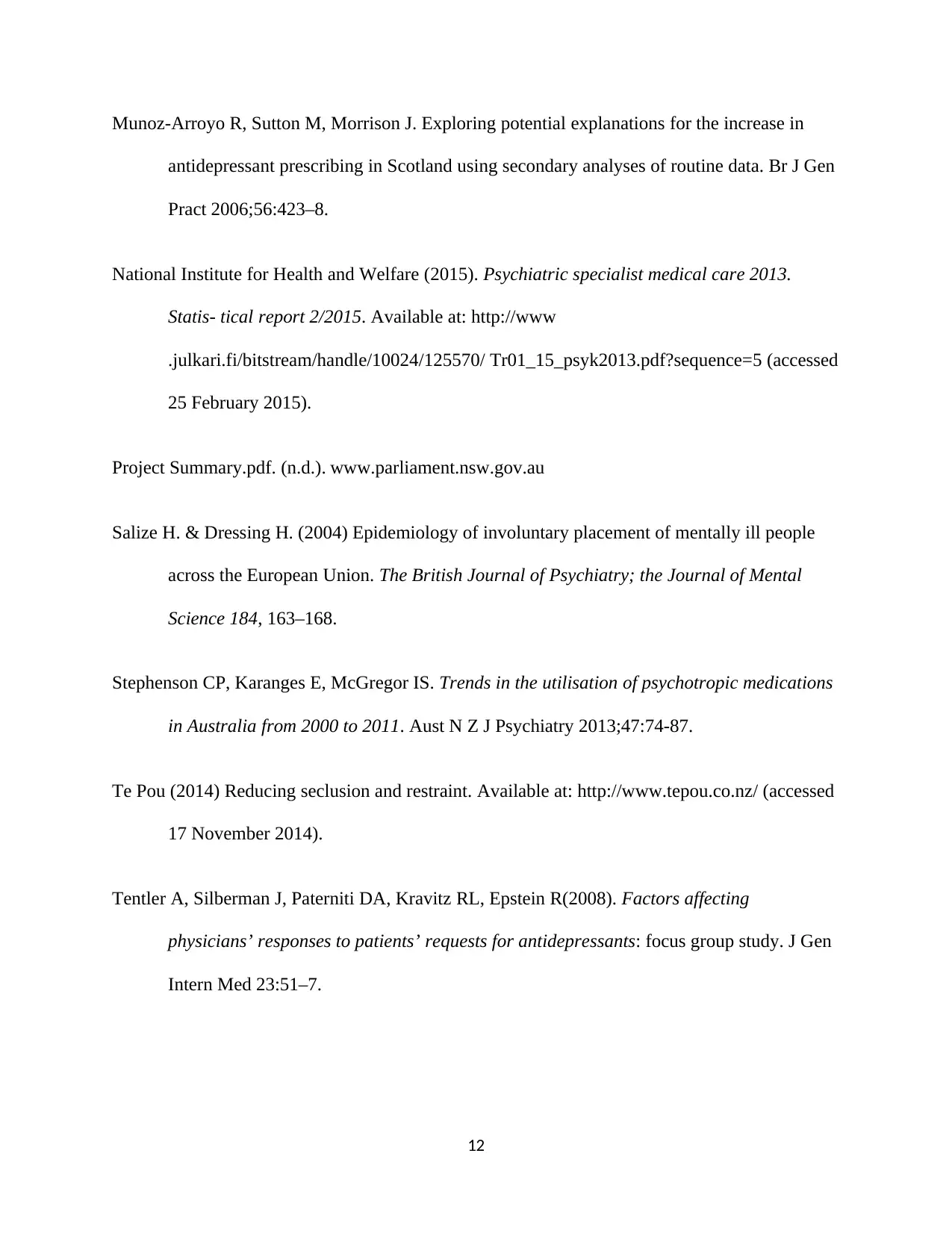
Munoz-Arroyo R, Sutton M, Morrison J. Exploring potential explanations for the increase in
antidepressant prescribing in Scotland using secondary analyses of routine data. Br J Gen
Pract 2006;56:423–8.
National Institute for Health and Welfare (2015). Psychiatric specialist medical care 2013.
Statis- tical report 2/2015. Available at: http://www
.julkari.fi/bitstream/handle/10024/125570/ Tr01_15_psyk2013.pdf?sequence=5 (accessed
25 February 2015).
Project Summary.pdf. (n.d.). www.parliament.nsw.gov.au
Salize H. & Dressing H. (2004) Epidemiology of involuntary placement of mentally ill people
across the European Union. The British Journal of Psychiatry; the Journal of Mental
Science 184, 163–168.
Stephenson CP, Karanges E, McGregor IS. Trends in the utilisation of psychotropic medications
in Australia from 2000 to 2011. Aust N Z J Psychiatry 2013;47:74-87.
Te Pou (2014) Reducing seclusion and restraint. Available at: http://www.tepou.co.nz/ (accessed
17 November 2014).
Tentler A, Silberman J, Paterniti DA, Kravitz RL, Epstein R(2008). Factors affecting
physicians’ responses to patients’ requests for antidepressants: focus group study. J Gen
Intern Med 23:51–7.
12
antidepressant prescribing in Scotland using secondary analyses of routine data. Br J Gen
Pract 2006;56:423–8.
National Institute for Health and Welfare (2015). Psychiatric specialist medical care 2013.
Statis- tical report 2/2015. Available at: http://www
.julkari.fi/bitstream/handle/10024/125570/ Tr01_15_psyk2013.pdf?sequence=5 (accessed
25 February 2015).
Project Summary.pdf. (n.d.). www.parliament.nsw.gov.au
Salize H. & Dressing H. (2004) Epidemiology of involuntary placement of mentally ill people
across the European Union. The British Journal of Psychiatry; the Journal of Mental
Science 184, 163–168.
Stephenson CP, Karanges E, McGregor IS. Trends in the utilisation of psychotropic medications
in Australia from 2000 to 2011. Aust N Z J Psychiatry 2013;47:74-87.
Te Pou (2014) Reducing seclusion and restraint. Available at: http://www.tepou.co.nz/ (accessed
17 November 2014).
Tentler A, Silberman J, Paterniti DA, Kravitz RL, Epstein R(2008). Factors affecting
physicians’ responses to patients’ requests for antidepressants: focus group study. J Gen
Intern Med 23:51–7.
12
⊘ This is a preview!⊘
Do you want full access?
Subscribe today to unlock all pages.

Trusted by 1+ million students worldwide
1 out of 13
Related Documents
Your All-in-One AI-Powered Toolkit for Academic Success.
+13062052269
info@desklib.com
Available 24*7 on WhatsApp / Email
![[object Object]](/_next/static/media/star-bottom.7253800d.svg)
Unlock your academic potential
Copyright © 2020–2025 A2Z Services. All Rights Reserved. Developed and managed by ZUCOL.





